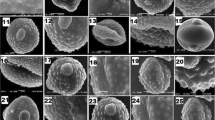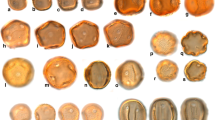Abstract
Pollen grains were extracted from sporangia of the pollen organ Permotheca sardykensis for the first time. The material originates from the middle Permian deposits of the Kostovaty locality (Udmurt Republic, Russia). The pollen grains were studied with light, scanning, and transmission electron microscopy. The pollen grains are rounded to oval, protobisaccate, with a leptoma. The sacci are very small and difficult to see under transmitted light, but, in a scanning electron microscope, differ from the corpus region in their sculpture (they can be distinguished by their psilate surface versus verrucate corpus sculpture). The leptoma was distinguished in the transmission electron microscope only by a considerable thinning of the pollen wall. The pollen wall consists of two layers which may be interpreted as a thick ectexine without a clear subdivision into sublayers and a thin endexine. Outside the pollen grains, remnants of a thin probable tapetal layer are present. The observed results could arise from pollen wall deterioration during diagenesis or incomplete pollen wall development. The pollen grains from the sporangia of P. sardykensis strongly differ from in situ pollen types which were described from other Permotheca species earlier or were associated with Peltaspermales. This may indicate a heterogeneity of the genus Permotheca.







Similar content being viewed by others
References
Afonin, S.A. 1999. Ultrastructure of Permian pollen grains of Vittatina. Paleontological Journal 33(4): 137–142. (in Russian).
Anderson, J.M., H.M. Anderson, and C.J. Cleal. 2007. Brief history of the gymnosperms: classification, biodiversity, phytogeography and ecology. Strelitzia 20: 1–279.
Balme, B.E. 1995. Fossil in situ spores and pollen grains: an annotated catalogue. Review of Palaeobotany and Palynology 87(2–4): 81–323.
Bolkhovitina, N.A. 1953. Spore-pollen characterization of the Cretaceous deposits of the central regions of the USSR. Trudy Akademii Nauk SSSR 145. Geologicheskaya seriya 61: 1–184. (in Russian).
Cookson, I.C. 1947. Plant microfossils from lignites of Kerguelen Archipelago. BANZ Antarctic Research Expedition 1929–1931 Reports (Series A) 2: 127–142.
Daugherty, L.H., and H.R. Stagner. 1941. The upper triassic flora of Arizona. Carnegie Institution of Washington, Publication 526: 1–108.
Dickinson, H.G., and P.R. Bell. 1970. The development of the sacci during pollen formation in Pinus banksiana. Grana 10(2): 101–108.
Erdtman, G. 1947. Suggestions for the classification of fossil and recent pollen grains and spores. Svensk botanisk tidskrift 41(1): 104–114.
Foraponova, T.S., and E.V. Karasev. 2019. New data on the flora from the Kazanian–Urzhumian Chepanikha locality (Udmurt Republic, Russia). In X A.N. Kryshtofovich Memorial Lectures, Saint-Petersburg, September 23–24, 2019, 54. (in Russian).
Gomankov, A.V. 2008. The Tatarian peltasperms of the Russian Platform: morphology, ecology, and evolution. Questions of Paleofloristics and Systematics of Fossil Plants (Lectures in Commemoration of A.N. Kryshtofovich) 6: 42–60. (in Russian).
Gomankov, A.V. 2010. Conifers from the Permian deposits of the Kargala mines (Southern Cisurals). Paleobotanika 1: 5–21. (in Russian).
Gomankov, A.V. 2012. Kostovaty floristic assemblage and the problem of the Kazanian–Urzhumian boundary at the East European Platform. In III All-Russian meeting “Upper Paleozoic of Russia: regional stratigraphy, paleontology, geo- and bio-events”, 70–72. (in Russian).
Gomankov, A.V. 2018. Rhipidopsis-like leaves in the upper Permian of the East European Platform and some tendencies in the ginkgoopsids evolution. Paleobotanical chronicle. Supplement to the «Lethaea rossica» journal 3: 41–49. (in Russian).
Gomankov, A.V. 2019. Flora of the Kazanian-Urzhumian boundary in the middle Permian of the Russian Platform. Palaeoworld. https://doi.org/10.1016/j.palwor.2019.01.005.
Gomankov, A.V., and S.V. Meyen. 1979. On members of the family Peltaspermaceae from the Permian of the Russian Platform. Paleontological Journal 1979(2): 124–138. (in Russian).
Gomankov, A.V., and S.V. Meyen. 1980. About correspondence between assemblages of plant macro- and microfossils in the Permian of Angaraland. Paleontological Journal 1980(4): 114–122. (in Russian).
Gomankov, A.V., and S.V. Meyen. 1986. Tatarina flora (composition and distribution in Late Permian of Eurasia). Trudy Geologicheskogo Instituta Akademii Nauk SSSR 401: 3–174. (in Russian).
Gomankov, A.V., and V.F. Tarasevich. 2008. Ultrastructure of some Vittatina-like pollen grains from the Permian of the Russian Platform. In Palynology: Stratigraphy and Geoecology. Collection of Scientific Papers to XII All-Russian Palynological Conference, vol.1, 48–53. St. Petersburg: VNIGRI. (in Russian).
Gomankov, A.V., and V.F. Tarasevich. 2011. Verrucate Vittatina-like pollen grains from the Permian of the East European Platform and the ultrastructure. In Problems of Modern Palynology. XIII Russian palynological conference, vol. 1, 20–22. Komi: Science Centre of the Ural Branch of the Russian Academy of Sciences. (in Russian).
Halbritter, H., S. Ulrich, F. Grímsson, M. Weber, R. Zetter, M. Hesse, R. Buchner, M. Svojtka, and A. Frosch-Radivo. 2018. Illustrated pollen terminology. Cham: Springer.
Hart, G.F. 1964. A review of the classification and distribution of the Permian miospores: Disaccate Striatiti. In 5ème Congrés de Stratigraphie et de Géologie du Carbonifère, Paris 1963, vol. 3, 1171–1199. Paris: Louis-Jean.
Hart, G.F. 1965. The systematics and distribution of Permian miospores. Johannesburg: Witwatersrand Univ. Press.
Jansonius, J. 1962. Palynology of Permian and Triassic sediments, Peace River Area, Western Canada. Palaeontographica (B: Paläophytologie) 110(1–4): 35–98.
Klaus, W. 1963. Sporen aus dem südalpinen Perm. Jahrbuch der Geologischen Bundesanstalt 106: 229–361.
Koloda, N.A. 1986. On the classification of Vittatina. Theory and Practice of Palynological Studies of the Permian and Triassic in USSR: 12–17. (in Russian).
Koloda, N.A. 1997. On the morphology and taxonomy of Permian striate pollen. Syktyvkar Proceedings of Institute of Geology of Komi Branch of Ural Department of the Academy of Sciences of USSR 91: 74–81. (in Russian).
Krassilov, V.A., S.A. Afonin, and S.V. Naugolnykh. 1999a. Permotheca with in situ pollen grains from the Lower Permian of the Urals. Palaeobotanist 48: 19–25.
Krassilov, V.A., A.P. Rasnitsyn, and S.A. Afonin. 1999b. Pollen morphotypes from the intestine of a Permian booklouse. Review of Palaeobotany and Palynology 106: 89–96.
Kurmann, M.H. 1986. Pollen wall ultrastructure and development in selected gymnosperms. PhD thesis, The Ohio State University, Columbus.
Kurmann, M.H. 1989. Pollen wall formation in Abies concolor and a discussion on wall layer homologies. Canadian Journal of Botany 67: 2489–2504.
Lambert, A.B., F. Bauer, and D. Don. 1803. Description of the genus Pinus: illustrated with figures, directions relative to the cultivation, and remarks on the uses of the several species. London: T. Bensley, Bolt Court.
Meyen, S.V. 1984. Basic features of gymnosperm systematics and phylogeny as evidenced by the fossil record. The Botanical Review 50(1): 1–111.
Meyen, S.V. 1987. Principles of paleobotany. Moscow: Nedra. (in Russian).
Meyen, S.V., and A.V. Gomankov. 1971. New data on the systematics of the phylladoderms and their geographic distribution. Doklady AN SSSR 198(3): 676–679. (in Russian).
Naugolnykh, S.V. 1998. Kungurian Flora of the Middle Cis-Urals. Moscow: GEOS. (in Russian).
Naugolnykh, S.V. 2007. Permian floras of the Urals. Transactions of the Geological Institute 524: 1–322. Moscow: GEOS. (in Russian).
Naugolnykh, S.V. 2013. New male reproductive organs of gymnosperms Permotheca colovratica sp. nov. from the Lower Permian of the Ural mountains. Paleontological Journal 47(1): 114–126.
Naugolnykh, S.V., and H. Kerp. 1996. Aspects of Permian palaeobotany and palynology. XV. On the oldest known peltasperms with radially symmetrical ovuliferous discs from the Kungurian (uppermost Lower Permian) of the Fore-Urals (Russia). Review of Palaeobotany and Palynology 91(1–4): 35–62.
Neuburg, M.F. 1960. Leafy mosses from the Permian deposits of Angaraland. Trudy Geologicheskogo Instituta 19: 1–104. (in Russian).
Neuburg, M.F. 1965. Permian flora of the Pechora basin, pt. III. Cordaitales, Vojnovskyales and seeds of gymnosperms. Trudy Geologicheskogo Instituta Akademii Nauk SSSR 116: 5–144.
Osborn, J.M., and T.N. Taylor. 1993. Pollen morphology and ultrastructure of the Corystospermales: permineralized in situ grains from the Triassic of Antarctica. Review of Palaeobotany and Palynology 79: 205–219.
Potonié, R. 1931. Pollenformen der miocänen Braunkohle (2. Mitteilung). Sitzungsberichte der Gesellschaft Naturforschender Freunde zu Berlin 1(3): 24–29.
Punt, W., P.P. Hoen, S. Blackmore, S. Nilsson, and A. Le Thomas. 2007. Glossary of pollen and spore terminology. Review of Palaeobotany and Palynology 143(1–2): 1–81.
Retallack, G.J. 2002. Lepidopteris callipteroides, an earliest Triassic seed fern of the Sydney Basin, southeastern Australia. Alcheringa 26(4): 475–500.
Rowley, J.R., J.S. Rowley, and J.J. Skvarla. 1990. Corroded exines from Havinga’s leaf mold experiment. Palynology 14: 53–79.
Samoilovich, S.R. 1953. Pollen grains and spores from the Permian deposits of the Cherdynskiy and Aktyubinskiy Cis-Urals. In Palaeobotanical Collection, ed. I.A. Korobkov, 7–51. Moscow: Gostoptekhizdat. (in Russian).
Schemel, M.P. 1951. Small spores of the Mystic coal of Iowa. The American Midland Naturalist 46: 743–750.
Taylor, E.L., T.N. Taylor, and M. Krings. 2009. Paleobotany: the biology and evolution of fossil plants. Academic Press and Elsevier.
Taylor, T.N., M.A. Cichan, and A.M. Baldoni. 1984. The ultrastructure of mesozoic pollen: Pteruchus dubius (Thomas) Townrow. Review of Palaeobotany and Palynology 41: 319–327.
Thomas, H.H. 1932. On some pteridospermous plants from the Mesozoic rocks of South Africa. Philosophical Transactions of the Royal Society of London (B: Biological Sciences) 222: 193–265.
Utting, J. 1994. Palynostratigraphy of Permian and Lower Triassic rocks, Sverdrup Basin, Canadian Arctic Archipelago. Geological Survey of Canada, Bulletin 478: 1–118.
Vasil, I.K. 1978. The ultrastructure of pollen development in gymnosperms. Bulletin de la Société Botanique de France. Actualités Botaniques 125(1–2): 115–120.
Wilson, L.R. 1962. Permian plant microfossils from the Flowerpot Formation, Greer County, Oklahoma. Norman: University of Oklahoma.
Wodehouse, R.P. 1933. Tertiary pollen II. The oil shales of the Eocene Green River Formation. Bulletin of the Torrey Botanical Club 60: 479–524.
Zalessky, M.D. 1929. Sur des débris de nouvelles plantes permiennes. Bulletin de l’Academie des Sciences de l’URSS (VII série) 7: 677–689.
Zalessky, M.D. 1932. Observations sur les végétaux nouveau paléozoïques de Siberia. Annales de la Société Géologique du Nord 57: 111–134.
Zalessky, M.D. 1937. Sur la distinction de l’etage Bardien dans le Permien de l’Oural et sur sa flore fossile. Problems of Paleontology 2–3: 37–101.
Zalessky, G. 1939. Études des insectes Permiens du bassin de la Sylva et problèmes de l’évolution dans la classe des insectes. III. Quelques nouveaux représentants des Protohymenoptera, Homoptera, Hemipsocoptera, Psocoptera, Protoperlaria, Isoptera et Protoblattoidea. Problemy Paleontologii 5: 66–91.
Zavada, M.S., and W.L. Crepet. 1985. Pollen wall ultrastructure of the type material of Pteruchus africanus, P. dubius and P. papillatus. Pollen et Spores 27(2): 271–276.
Zavialova, N.E., and E.V. Karasev. 2015. Exine ultrastructure of in situ Protohaploxypinus from a Permian peltasperm pollen organ, Russian Platform. Review of Palaeobotany and Palynology 213: 27–41.
Zavialova, N.E., N.R. Meyer-Melikian, and A.V. Gomankov. 2001. Ultrastructure of some Permian pollen grains from the Russian Platform. In Proceedings of the IX International Palynological Congress, Houston, Texas, U.S.A., 1996, eds. D.K. Goodman, and R.T. Clarke: 99–114. Dallas, Tex.: American Association of Stratigraphic Palynologists Foundation.
Zavialova, N.E., M.V. Tekleva, S.V. Polevova, and A.G. Bogdanov. 2018. Electron microscopy for morphology of pollen and spores. Moscow: RIPOL Classic Press.
Acknowledgements
The author would like to thank Dr. A.V. Gomankov (Komarov Botanical Institute, St-Petersburg, Russia), who kindly provided his material for this study, Dr. N.E. Zavialova (Borissiak Paleontological Institute, Moscow, Russia) and Dr. E.V. Karasev (Borissiak Paleontological Institute, Moscow, Russia) for their invaluable help and advice at all stages of the paper preparation, Dr. M.V. Tekleva (Borissiak Paleontological Institute, Moscow, Russia) for her comments on the text, N.I.Gabaraeva (Komarov Botanical Institute, St-Petersburg, Russia), and S.V. Polevova (Lomonosov Moscow State University, Moscow, Russia) for their help. Additional thanks to H. Nowak (Museum of Nature South Tyrol, Bolzano, Italy), E. Kustatscher (Museum of Nature South Tyrol, Bolzano, Italy), and anonymous reviewers for their comments, thanks to which article was significantly supplemented, and M. Reich (Bavarian State Collection of Palaeontology and Geology, Munich, Germany) for his corrections. The study was supported by the Russian Foundation for Basic Research, project no. 19-04-00498 a and PaISIRP Sepkoski Grant 2018.
Author information
Authors and Affiliations
Corresponding author
Additional information
Handling Editor: Hans-Georg Herbig.
Rights and permissions
About this article
Cite this article
Foraponova, T. First data on in situ pollen of Permotheca sardykensis Zalessky 1929 from the middle Permian of the Russian Platform. PalZ 96, 575–589 (2022). https://doi.org/10.1007/s12542-021-00558-7
Received:
Accepted:
Published:
Issue Date:
DOI: https://doi.org/10.1007/s12542-021-00558-7




